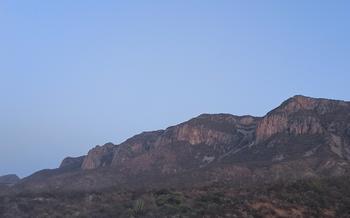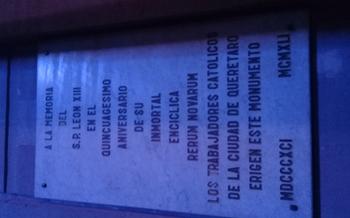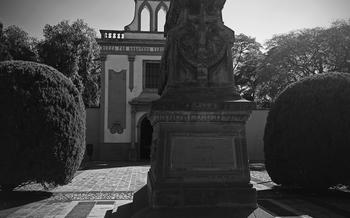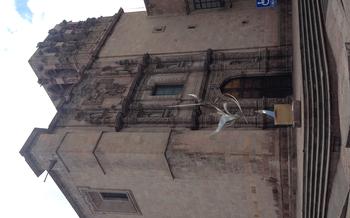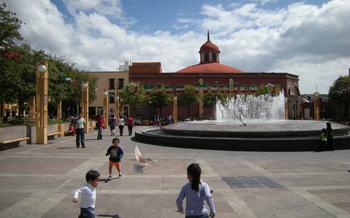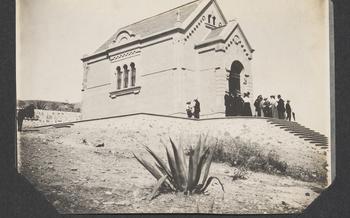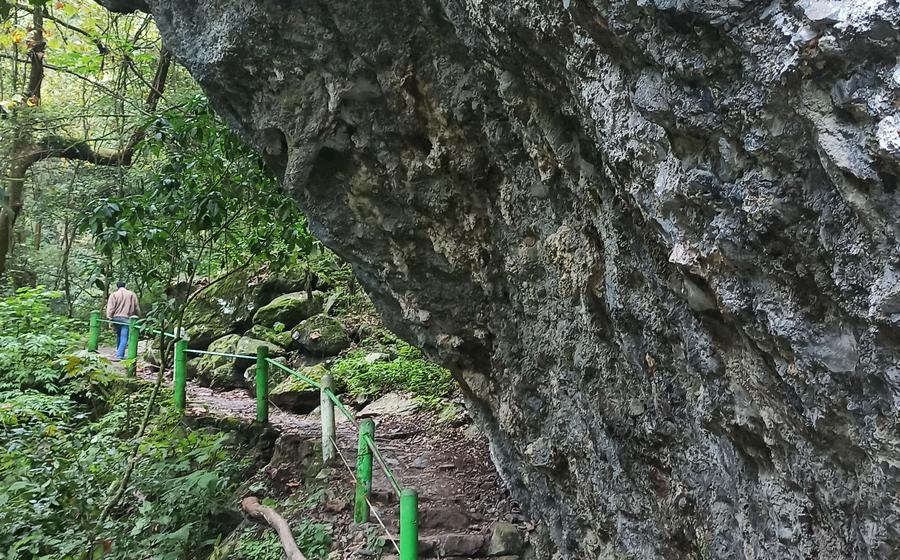
El Acueducto Viewing Point
- El Acueducto Viewing Point: A Historical Landmark
- Location and Accessibility
- Panoramic City Views
- The Aqueduct's Engineering Marvel
- Historical Significance
- Best Time to Visit
- Things to Do Nearby
- Guided Tours and Local Insights
- Photography Tips
- Cultural Significance
- Accessibility for Differently-Abled Visitors
- Maintenance and Preservation Efforts
- Insider Tip: Hidden Gem
El Acueducto Viewing Point: A Historical Landmark
El Acueducto Viewing Point stands as a testament to the rich history and architectural prowess of Queretaro, Mexico. This iconic aqueduct, constructed in the 18th century, played a pivotal role in providing clean water to the city's growing population. Its impressive design and engineering marvels earned it recognition as a UNESCO World Heritage Site in 20
The aqueduct's construction began in 1726 under the direction of Spanish engineer Juan Antonio de Urrutia. It took over 25 years to complete, with the final section being finished in 175The structure consists of 74 arches, each spanning approximately 12 meters. The total length of the aqueduct is an impressive 1,280 meters, making it one of the longest aqueducts in Mexico.
The aqueduct's architectural style is a blend of Baroque and Neoclassical elements. The arches are adorned with intricate carvings and sculptures, while the facade features a series of decorative niches and fountains. The aqueduct's design not only served a practical purpose but also showcased the artistic talents of the era.
El Acueducto played a crucial role in Queretaro's development. Prior to its construction, the city faced severe water shortages, particularly during the dry season. The aqueduct's completion ensured a steady supply of clean water, which greatly improved the health and living conditions of the population.
Location and Accessibility
The El Acueducto Viewing Point is located in the heart of Queretaro, offering easy access to both locals and tourists. Its exact address is Calle Vicente Guerrero, Centro Histórico, 76000 Santiago de Querétaro, Qro. To reach the viewpoint, visitors can take advantage of the city's well-developed public transportation system. Several bus lines, including routes 19, 23, and 37, stop within a short walking distance of the site. Alternatively, visitors can opt for the convenience of driving their private vehicles. Ample parking facilities are available in the vicinity, ensuring a hassle-free experience. Additionally, the viewpoint is designed to be accessible for differently-abled visitors. Wheelchair ramps and designated parking spaces are provided to facilitate a comfortable and enjoyable visit for all.
Panoramic City Views
El Acueducto Viewing Point offers breathtaking vistas of Queretaro city that will leave you in awe. From this elevated platform, you can feast your eyes on a tapestry of colorful buildings, sprawling streets, and iconic landmarks that define the city's skyline.
The viewpoint provides a unique perspective to explore Queretaro's layout and identify its most prominent features. The majestic spires of the Templo de San Francisco and the intricate facade of the Teatro de la República stand out against the cityscape, beckoning you to discover their historical significance.
Capture the beauty of Queretaro with panoramic photographs that will serve as lasting mementos of your visit. The elevated vantage point allows you to frame the entire city within your lens, creating stunning compositions that showcase its architectural diversity and vibrant energy.
The Aqueduct's Engineering Marvel
The El Acueducto Viewing Point showcases an impressive feat of engineering that has stood the test of time. Constructed in the 18th century, the aqueduct is a testament to the ingenuity and skill of its builders. The structure consists of 74 arches, each measuring over 10 meters in height, and extends for a total length of 1,280 meters.
The construction of the aqueduct presented numerous challenges, including the uneven terrain and the need to transport water over long distances. Engineers employed innovative techniques to overcome these obstacles, such as using lime mortar to bind the stones and creating a system of underground channels to distribute water throughout the city.
The aqueduct's design also incorporates several notable features, including buttresses and arches that provide structural stability and allow for the efficient flow of water. These features not only contribute to the aqueduct's functionality but also enhance its aesthetic appeal, making it a true architectural masterpiece.
Comparisons with other notable aqueducts around the world further highlight the engineering prowess behind El Acueducto. While the Roman aqueducts are renowned for their size and longevity, El Acueducto stands out for its innovative design and adaptation to the local topography. Its unique blend of functionality and aesthetics makes it a remarkable example of engineering excellence.
Historical Significance
The El Acueducto has played a pivotal role in the development of Queretaro, serving as a crucial water supply system for the city's growing population. Constructed during a time when access to clean water was a significant challenge, the aqueduct brought forth a new era of sanitation and improved public health. Its presence transformed Queretaro into a thriving hub of commerce and industry, attracting settlers and businesses alike.
Beyond its practical function, the aqueduct stands as a symbol of Queretaro's resilience and ingenuity. Despite the formidable engineering challenges posed by the city's hilly terrain, the aqueduct's builders persevered, showcasing their exceptional skills and determination. The structure's endurance through centuries of natural disasters and urban development serves as a testament to the enduring spirit of Queretaro's people.
Recognizing its historical and cultural significance, the El Acueducto has been designated as a UNESCO World Heritage Site, an honor bestowed upon landmarks of outstanding universal value. This designation underscores the aqueduct's importance not only to Queretaro but also to the world's architectural and engineering heritage.
Today, the El Acueducto stands as a cherished symbol of Queretaro's past, a reminder of the city's humble beginnings and its remarkable transformation into a vibrant metropolis. Preservation efforts and restoration projects are continuously undertaken to ensure that this architectural masterpiece remains a source of pride and inspiration for generations to come.
Best Time to Visit
Timing is crucial when visiting El Acueducto Viewing Point to fully appreciate its beauty and significance. The ideal time of day to visit is during the late afternoon, as the golden hues of the setting sun cast a warm glow on the city, creating a picturesque scene. During this time, the shadows are longer, enhancing the dramatic effect of the aqueduct's silhouette against the vibrant sky.
While the viewpoint is accessible throughout the year, the weather conditions vary depending on the season. Queretaro experiences a temperate climate, with warm and dry summers and mild winters. The best time to visit the city, and the viewpoint, is during the shoulder seasons, which fall between March and May and September and November. During these months, the weather is pleasant, with moderate temperatures and fewer crowds, allowing for a more enjoyable and relaxed visit.
Throughout the year, El Acueducto Viewing Point hosts special events and festivals that add to its allure. The annual Festival Internacional de Queretaro, held in July, showcases local and international music, dance, and theater performances, providing a vibrant backdrop to your visit. During the Christmas season, the viewpoint is adorned with festive decorations, creating a magical atmosphere.
To avoid peak tourist hours, it is advisable to visit the viewpoint early in the morning or late in the afternoon. This will allow you to experience the tranquility of the site without the hustle and bustle of large crowds. Whether you choose to visit during the golden hour of sunset, the vibrant shoulder seasons, or a special event, El Acueducto Viewing Point offers a unique and memorable experience at any time of the year.
Things to Do Nearby
Beyond the breathtaking views, the El Acueducto Viewing Point is surrounded by a wealth of attractions that invite exploration. Within easy walking distance, visitors can immerse themselves in Queretaro's rich history and vibrant culture. A short stroll leads to the Templo de Santa Rosa de Viterbo, a 17th-century church showcasing intricate Baroque architecture. The Museo de la Ciudad, housed in a former convent, offers a fascinating glimpse into the city's past through exhibits on local history, art, and traditions.
For those seeking culinary delights, the surrounding area abounds with charming restaurants and cafes. Savor authentic Mexican cuisine at La Mariposa, a local favorite known for its mouthwatering enchiladas and pozole. Indulge in artisanal coffee and pastries at La Buena Vida Cafe, a cozy spot with a warm and inviting atmosphere.
Shoppers will delight in the array of local handicrafts and souvenirs available at nearby markets and boutiques. From colorful pottery and intricately woven textiles to hand-crafted jewelry and traditional Mexican candies, there's something for every taste and budget. Explore the bustling Mercado de la Cruz, where vendors display their wares amidst the lively atmosphere of the city's main market. Discover unique pieces at the Artisan Market, showcasing the work of local artisans and craftspeople.
Guided Tours and Local Insights
Enhance your visit to El Acueducto Viewing Point by joining a guided tour led by knowledgeable local experts. These tours offer a deeper understanding of the site's history, cultural significance, and engineering marvels. Listen to engaging storytelling as your guide brings the aqueduct's past to life, sharing anecdotes, legends, and insights into the lives of the people who built and used it.
Guided tours provide a comprehensive overview of the aqueduct's construction, challenges, and innovations, allowing you to appreciate its architectural brilliance. Learn about the innovative techniques employed by engineers to overcome obstacles such as uneven terrain and water scarcity. Discover the role of the aqueduct in shaping Queretaro's development and its enduring legacy as a symbol of the city's resilience.
By booking a guided tour, you'll gain exclusive access to restricted areas, hidden corners, and vantage points not accessible to the general public. Your guide will point out intricate details, historical markers, and architectural features that you might otherwise miss. They'll also recommend the best angles for capturing stunning photographs and share tips for making the most of your visit.
Whether you're a history buff, an architecture enthusiast, or simply curious about Queretaro's cultural heritage, a guided tour of El Acueducto Viewing Point is an enriching and unforgettable experience. Embrace the opportunity to learn from local experts and gain a deeper appreciation for this architectural masterpiece and its profound impact on the city of Queretaro.
Photography Tips
To capture the beauty of El Acueducto and the panoramic city views, here are some photography tips:
-
Camera Settings: Use a wide-angle lens to fit the entire aqueduct and the cityscape into the frame. A tripod is essential for stability, especially during low-light conditions. Set your camera to a low ISO (100-200) to minimize noise.
-
Angles and Vantage Points: Experiment with different angles to create dynamic compositions. Shoot from the front of the aqueduct to emphasize its grandeur, or from the side to capture its length and scale. For a unique perspective, climb the nearby hill to get a bird's-eye view.
-
Tripod Recommendations: Invest in a sturdy tripod to ensure sharp and blur-free images. A tripod with a ball head will give you the flexibility to adjust the camera's position and angle.
-
Composition Tips: Pay attention to the placement of the aqueduct in the frame. Position it off-center to create a more interesting composition. Include foreground elements like trees or buildings to add depth and context to your shots.
Cultural Significance
The El Acueducto Viewing Point holds immense cultural significance for the city of Queretaro. It serves as a potent symbol of the city's identity, embodying its rich history and heritage. The aqueduct's enduring presence has woven it into the fabric of Queretaro's culture, becoming an integral part of local traditions and folklore. Its captivating form and historical significance have transformed it into an icon of the city, attracting visitors from far and wide who seek to delve into the heart and soul of Queretaro.
The aqueduct's role in the development and prosperity of Queretaro has earned it a place of honor in the hearts of the local community. It is a tangible reminder of the ingenuity and determination of the city's forefathers, who labored tirelessly to construct this engineering marvel. The aqueduct's resilience and longevity have become a source of pride for the people of Queretaro, who view it as a symbol of their city's unwavering spirit.
Furthermore, the El Acueducto Viewing Point has played a pivotal role in promoting cultural tourism in Queretaro. Its unique architectural features and historical significance have made it a popular destination for travelers seeking to explore the city's rich heritage. The viewpoint offers visitors a glimpse into Queretaro's past, allowing them to connect with the city's cultural roots and appreciate its enduring legacy.
Accessibility for Differently-Abled Visitors
El Acueducto Viewing Point welcomes visitors of all abilities, ensuring an inclusive and enjoyable experience for everyone. Wheelchair users can effortlessly access the viewpoint platform through designated ramps, providing unobstructed views of the city's skyline. Specially marked parking spaces are available nearby, ensuring convenient access for disabled individuals. For those requiring assistance, dedicated staff is on hand to provide guidance and support, facilitating a seamless and comfortable visit. The site's thoughtful design ensures that all visitors, regardless of their physical abilities, can fully appreciate the wonders of this iconic landmark.
Maintenance and Preservation Efforts
El Acueducto has stood the test of time for over two centuries, thanks to ongoing conservation efforts aimed at preserving its historical and cultural significance. Government agencies and heritage organizations work tirelessly to ensure that this iconic landmark remains intact for future generations.
One of the biggest challenges in preserving El Acueducto is balancing the need for accessibility with the need to protect its delicate structure. The constant flow of tourists and the impact of weather elements can take a toll on the aqueduct's integrity. To address this, authorities have implemented strict regulations on the number of visitors allowed on the viewpoint platform at any given time. They have also installed protective barriers and designated pathways to minimize damage to the structure.
Regular maintenance and restoration projects are also carried out to address any signs of deterioration. Experts carefully inspect the aqueduct's arches, pillars, and foundations to identify potential weaknesses or damage. Repairs are made using traditional techniques and materials to ensure that the aqueduct's historical character is preserved.
The preservation of El Acueducto is not just a technical endeavor; it is a cultural mission. This remarkable monument embodies the spirit of Queretaro and serves as a reminder of the city's rich history and heritage. By safeguarding El Acueducto, we are not only preserving a physical structure but also protecting the identity and legacy of Queretaro for generations to come.
Insider Tip: Hidden Gem
Beyond the main viewpoint platform, those seeking a secluded spot with a unique perspective can venture to a hidden gem nearby. Follow the path leading away from the viewpoint, and you'll stumble upon a charming little plaza nestled amidst lush greenery. This hidden oasis offers a tranquil ambiance, away from the crowds, and presents a different angle to capture stunning photographs of the aqueduct.
With the sun setting behind the arches of the aqueduct, the scene transforms into a magical spectacle. The warm golden hues illuminate the stone structure, casting long shadows that dance across the plaza. Seize this opportunity to capture breathtaking shots, experimenting with different angles and compositions to create truly unique and memorable images.
While exploring this hidden gem, remember to tread cautiously and respect the tranquility of the space. Embrace the solitude and use this opportunity to connect with the beauty and history of the aqueduct in a more intimate setting.
